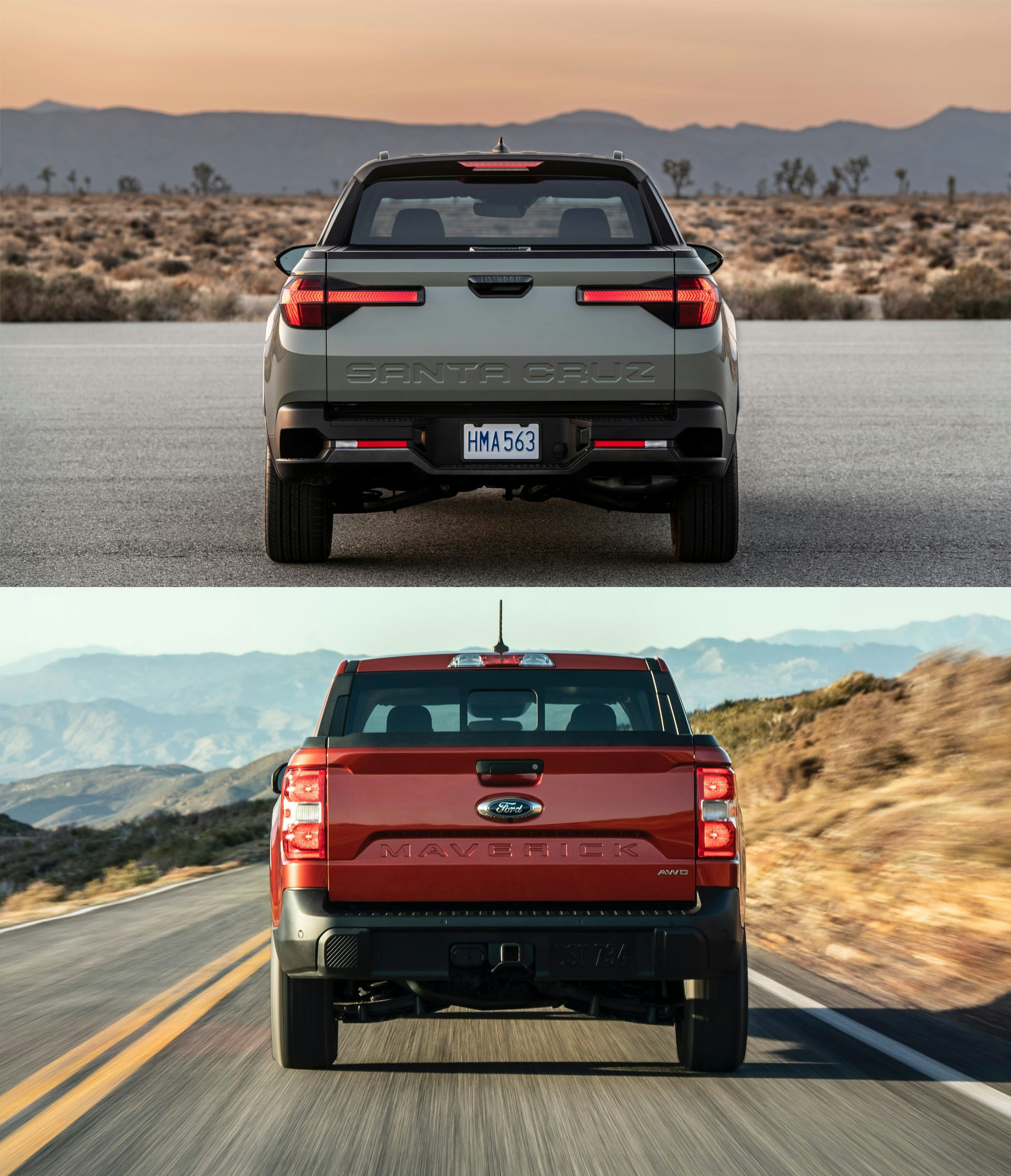
Seemingly out of nowhere, the microtruck trend is in full swing. The Ford Maverick and Hyundai Santa Cruz compact pickup trucks launched last year, and it’s probably safe to say that neither Ford nor Hyundai quite expected the reception they received.
Both vehicles have seen brisk sales, with the Santa Cruz knocking off the Chevrolet Corvette as the fastest-selling car on dealer lots. Ford has seen younger and female buyers attracted to the Maverick in numbers far exceeding its larger trucks.
The Maverick and Santa Cruz are roughly the same size, both ride on a unibody, car-esque platform, and they’re somewhat similar in price. But there are still significant differences, particularly in design and functionality.
If you’re trying to choose between these trucks and you haven’t made up your mind yet, here’s everything you need to know about how the trucks compare stats- and feature-wise, and the things you’ll want to consider as you make your compact pickup purchase decision.

Ford Maverick vs. Hyundai Santa Cruz: Price
Though Ford claims that the Maverick starts under $20,000, the base XL trim will run you $21,490 after a hefty $1,495 mandatory Destination Charge applied to every Maverick sale. That’s still a terrific price for a very capable truck, and I said in my review of the Maverick that it was one of the few vehicles where I’d be happy to have the base model for myself.
There are three trim levels for the Ford Maverick, with numerous options available on each:
- Maverick XL: $21,490 - Includes an 8-inch touchscreen with wired Apple CarPlay and Android Auto, steel wheels, and a hybrid powertrain with front-wheel drive.
- Maverick XLT: $23,855 - Adds cruise control, 17-inch aluminum wheels, power-adjustable side mirrors, and a nicer interior.
- Maverick Lariat: $27,355 - Adds LED headlights, 18-inch aluminum wheels, push-button start, a power driver seat, dual-zone climate control, and more.
All trim levels can be upgraded from the FWD 2.5L 4-cylinder hybrid to a more powerful but less efficient 2.0L turbocharged “EcoBoost” 4-cylinder engine ($1,085). All-wheel drive is an option if you also upgrade to the EcoBoost engine ($2,220). A fully-loaded Maverick Lariat can be optioned out to more than $36,000 without adding any of the myriad accessories Ford offers like bed caps, a tonneau cover, or toolboxes for the bed.
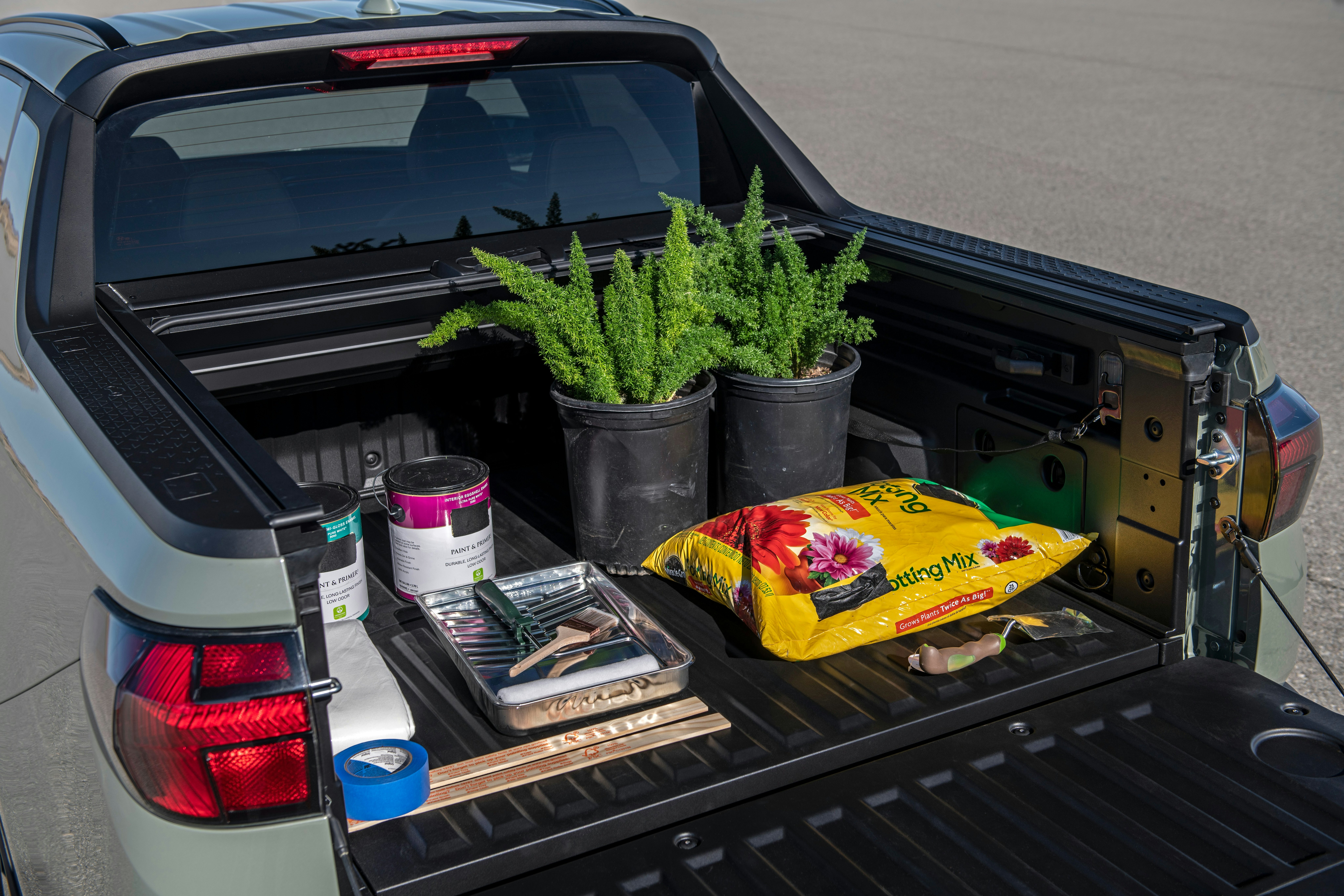
The Hyundai Santa Cruz starts at $25,685 for the base SE trim, after its own $1,245 destination charge, and prices go up significantly from there. As is typical for Hyundai, building a Santa Cruz is very simple: you pick your color (six different choices) and your trim. There are very few complicated option packages to choose from:
- Santa Cruz SE: $25,685 - Includes an 8-inch touchscreen with wireless Apple CarPlay and Android Auto. Upgrading to AWD is a $1,500 option.
- Santa Cruz SEL: $28,885 - Adds blind-spot warning and rear cross-traffic assist, a power driver seat, and push-button start. Upgrading to AWD is $1,500, while an Activity Package with neat tech and comfort features is $3,270.
- Santa Cruz SEL Premium: $37,375 - Adds a more powerful engine and all-wheel drive, a digital instrument cluster, and support for a digital smartphone key.
- Santa Cruz Limited: $41,415 - Adds a 10-inch touchscreen, plus 360-degree and blind-spot cameras when changing lanes.
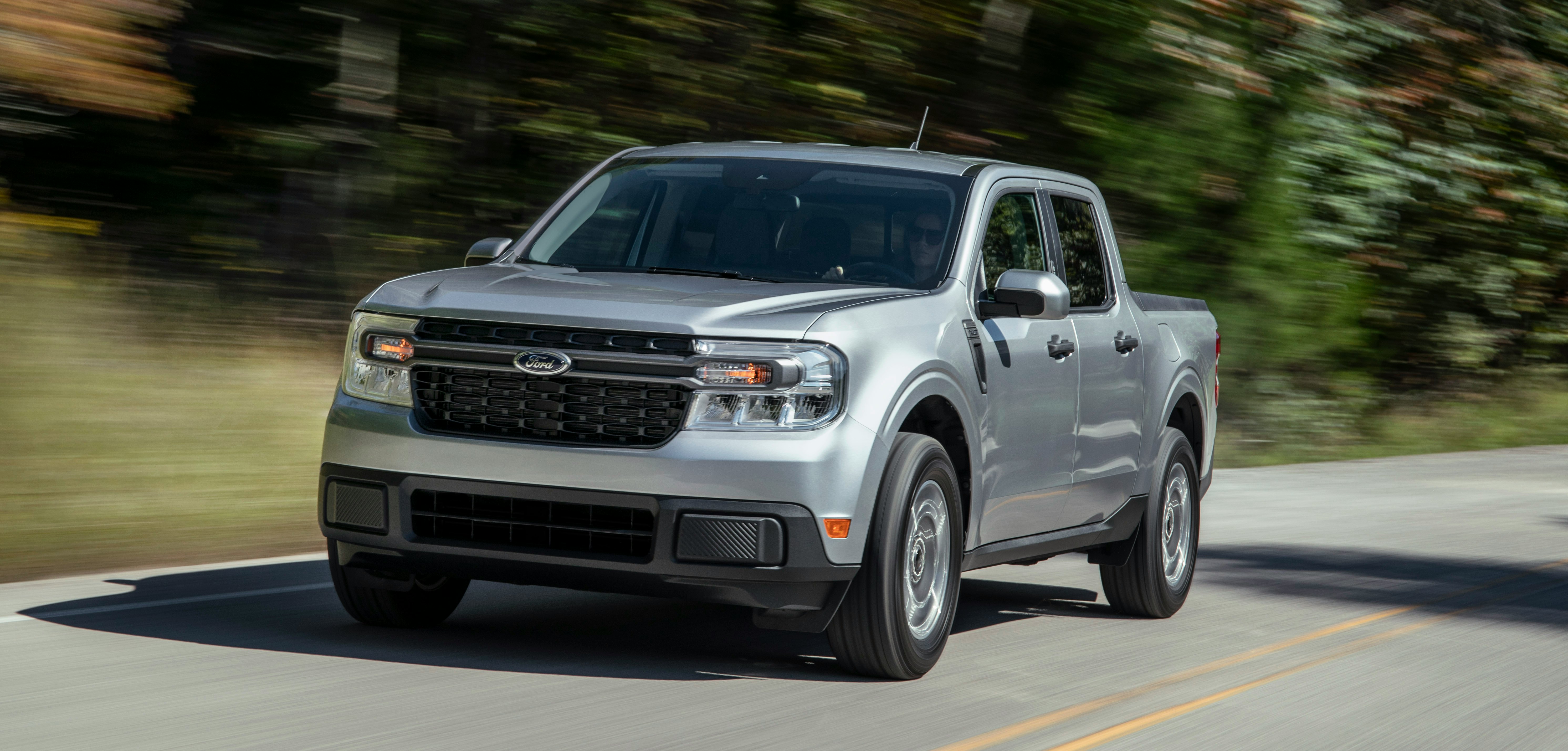
Ford Maverick vs. Hyundai Santa Cruz: Fuel Economy
There are three different powertrains for the Ford Maverick, each with different EPA-estimated fuel economy numbers:
- The FWD hybrid gets 42 city / 33 highway / 37 combined
- The FWD EcoBoost gets 23 city / 30 highway / 26 combined
- The AWD EcoBoost gets 22 city / 29 highway / 25 combined
There are also three different powertrains of the Hyundai Santa Cruz:
- The naturally aspirated 2.5L FWD gets 21 city / 26 highway / 23 combined
- The naturally aspirated 2.5L AWD gets 21 city / 27 highway / 23 combined
- The more powerful, turbocharged 2.5L AWD gets 19 city / 27 highway / 22 combined
The Ford Maverick has a clear advantage in fuel economy with both powertrains, but especially over the more powerful, turbocharged Santa Cruz — and that Maverick Hybrid returns some pretty incredible city fuel economy, too.

Ford Maverick vs. Hyundai Santa Cruz: Max Towing
The Hyundai Santa Cruz has a maximum towing capacity of 3,500 pounds (FWD) or 5,000 lbs (AWD) as long as trailer brakes are installed.
The Ford Maverick has a 2,000-pound maximum towing capacity for the hybrid or 4,000-pound max for the EcoBoost engine with the 4K Tow Package added.
Ford Maverick vs. Hyundai Santa Cruz: Max Payload
But the maximum towing weight is only one part of the towing equation. Max payload, or the total amount of passengers and cargo the vehicle can carry — including the tongue weight of the trailer on the hitch — also plays a role.
The Ford Maverick has a max payload of 1,500 pounds across all trims and powertrains.
The Hyundai Santa Cruz reports a “maximum load limit” of 1,411 pounds across all versions, but the max payload is specified between 1,521 pounds and 1,753 pounds — Hyundai specifies that the payload number is the gross vehicle weight rating of the vehicle minus its curb weight, which is a complicated way of saying “it depends.”
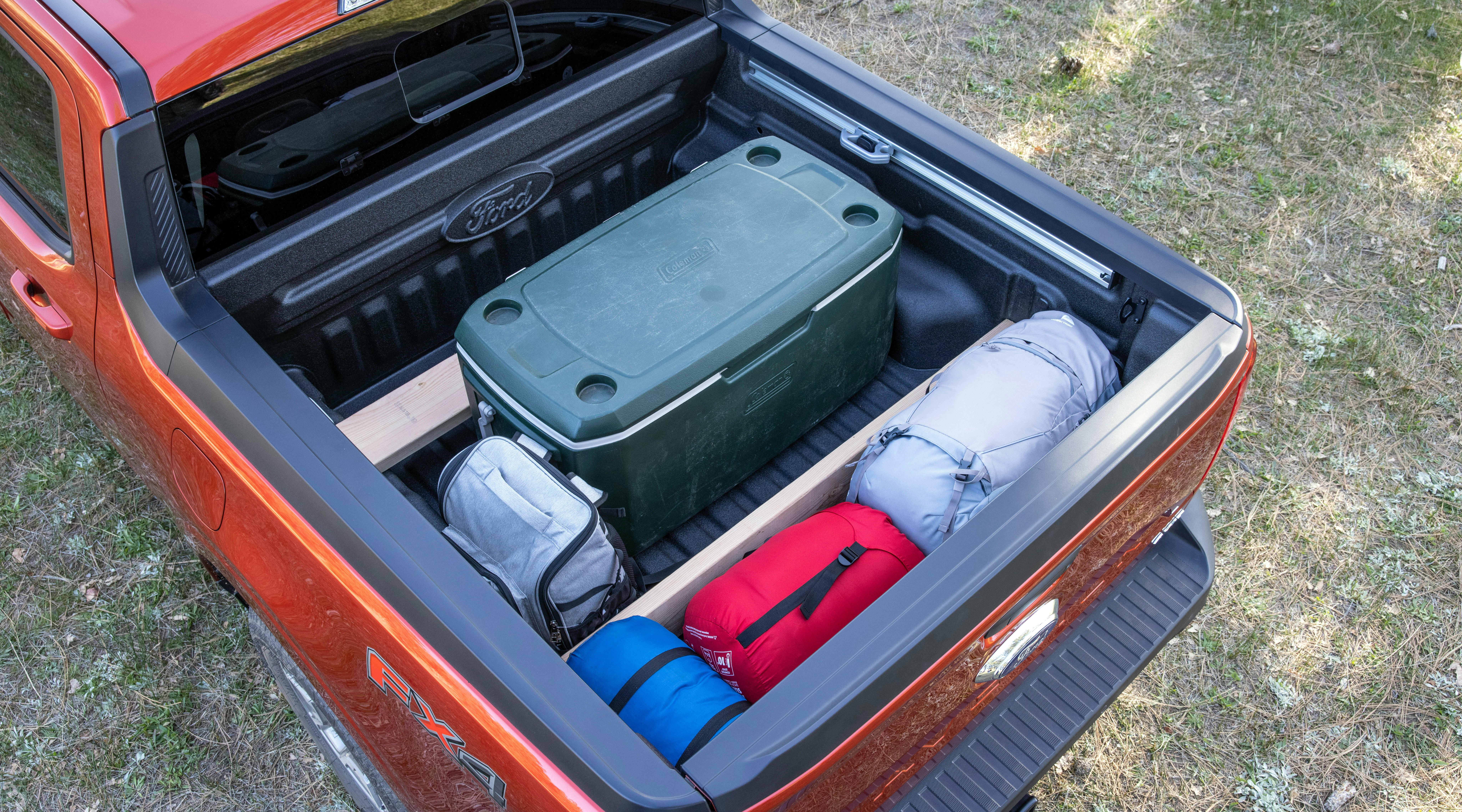
Ford Maverick vs. Hyundai Santa Cruz: Bed Size
The Maverick’s traditional pickup bed is about 4.5-feet long and about 20 inches high, for a total cargo volume of 33.3 cubic feet.
The Santa Cruz has a total bed volume of 27 cubic feet, with a bed length of 4.3-feet measured at the floor, and if you have the tonneau cover equipped, it takes up quite a bit of space at the far end of the bed. It does have in-bed under-floor storage, however.
Ford Maverick vs. Hyundai Santa Cruz: Cup Holders
The Ford Maverick has a scarcely believable 16 cup holders in the cabin — check this to see all of them — while the Hyundai Santa Cruz seems to have a rather pedestrian 6 cup holders.

Ford Maverick vs. Hyundai Santa Cruz: Off-Road Performance
The Ford Maverick has the following off-road stats for the FWD Hybrid/AWD versions:
- Approach Angle: 20.6 ̊ / 21.6 ̊
- Departure Angle: 21.9 ̊ / 21.2 ̊
- Breakover Angle: 16.6 ̊ / 18.1 ̊
- Ground clearance: 8.3” / 8.6”
The Hyundai Santa Cruz has the following stats:
- Approach Angle: 17.5 ̊
- Departure Angle: 23.2 ̊
- Breakover Angle: 18.6 ̊
- Ground clearance: 8.6”
Ford Maverick vs. Hyundai Santa Cruz: Driver Assist Features
Neither vehicle is self-driving, of course, but the Hyundai Santa Cruz does have an extensive list of available safety features. Automatic emergency braking with pedestrian detection is standard, as are lane-keeping assist and automatic high beams.
Blind-spot monitoring with avoidance assist is standard in SEL and up, as is rear cross-traffic collision avoidance assist. Rain-sensing wipers, adaptive cruise control (with navigation-aware curve speed adjustments), and an excellent highway drive assist lane-centering feature are included in the top-tier Limited trim.
The Ford Maverick includes standard automatic emergency braking with pedestrian detection and automatic high beams.
Cruise control is not standard with the base XL trim but is available on higher trims. Also available, depending on trim, are adaptive cruise with stop & go, evasive steering assist, lane centering and lane-keeping assist, blind-spot monitoring, and lane-departure warning.
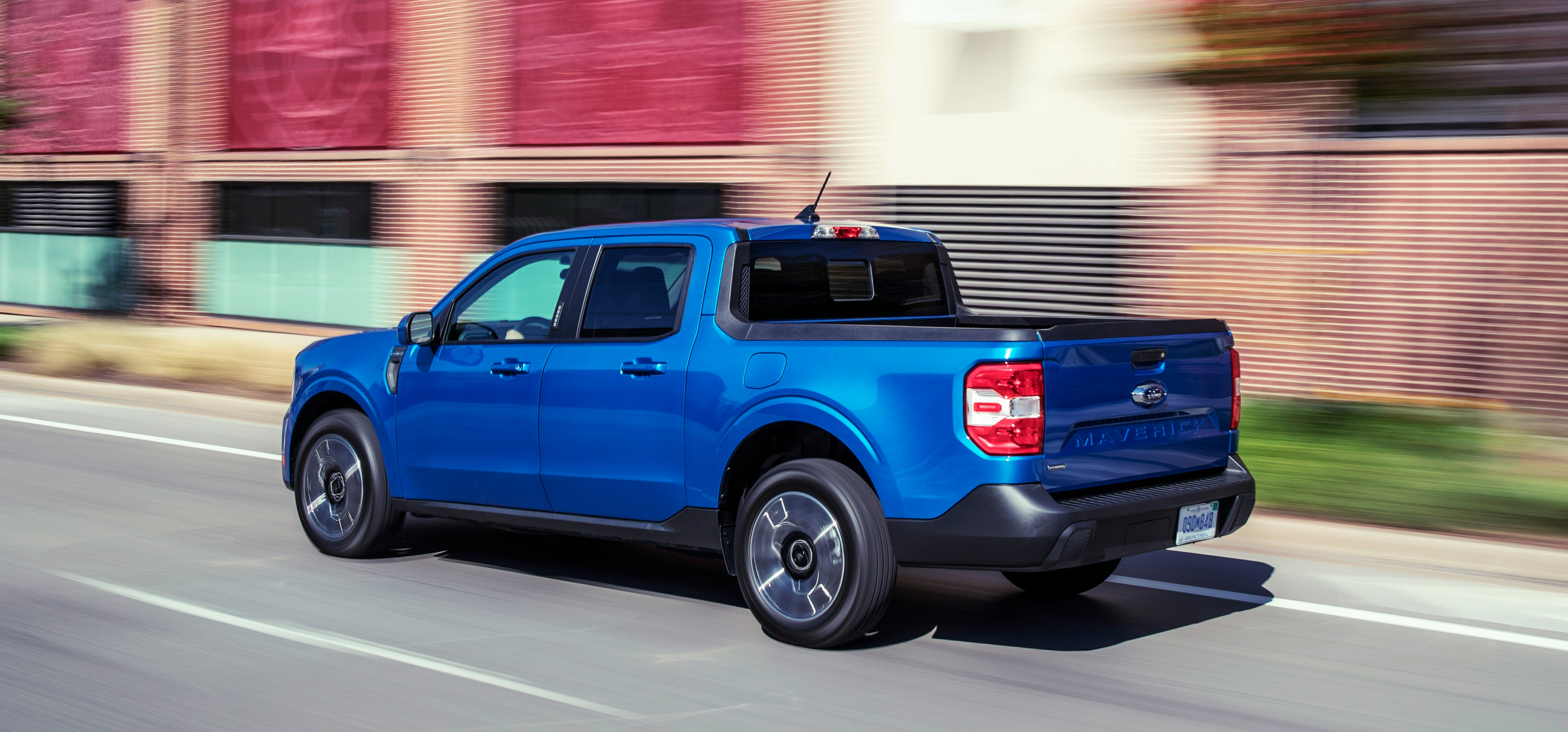
Ford Maverick vs. Hyundai Santa Cruz: Warranty
The Hyundai Santa Fe includes what Hyundai calls “America’s Best Warranty:”
- 5-year / 60,000-mile bumper-to-bumper warranty
- 10-year / 100,000-mile powertrain warranty
- 3 years / 36,000 miles of complimentary normal oil changes and rotations.
The Ford Maverick includes Ford’s standard warranty:
- 3-year / 36,000-mile bumper-to-bumper warranty
- 5-year / 60,000-mile powertrain warranty
- 5-year / 60,000-mile of complimentary roadside assistance
- 8-year / 100,000-mile hybrid unique components coverage (if equipped)
Ford Maverick vs. Hyundai Santa Cruz: Availability
Though both vehicles are in full production, they are also in significant demand. Ford told dealers back in January that it was suspending customer orders to focus on its order backlog. Still, it’s possible you can still find a Maverick at your local Ford dealer — however, you may need to pay a significant “market adjustment” (or dealer markup) to drive off with it.
Sign up for PRNDL to get my car reviews in your inbox, free every week.







